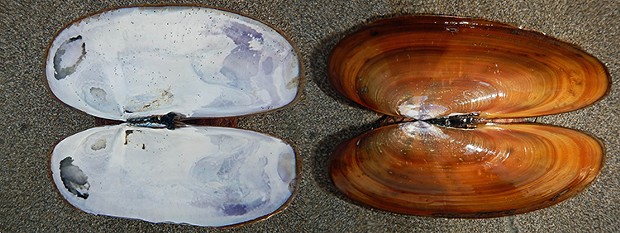[
{
"name": "Top Stories Video Pair",
"insertPoint": "7",
"component": "17087298",
"parentWrapperClass": "fdn-ads-inline-content-block",
"requiredCountToDisplay": "1"
}
]
The other day my imaginary friend said, "Your little stories there in the back pages of the local weekly ... They're OK."
"Just OK?" I asked.
"Yeah. They're too much like beachcomber pornography. You strut onto the beach, instantly presented with fantastic big squids. And your threesome with the lancetfish and spiny dogfish was hot but you're giving impressionable beachgoers unrealistic expectations. Tone it down — talk about clam shells or something."
My imaginary friend is usually a dumbass but I see clam shells every time I go to the beach. And clam shells can thrill. If you've ever had the sensation of a very deep itch being scratched upon finding a perfect clam shell, no need to be ashamed.
Let's consider the gorgeous Pacific razor clam (Siliqua patula). The inside of their shells feature a pretty purple and they make a satisfying crunch when you step on them. Being clams, the razor clam is a bivalve mollusc (or "mollusk" if you are intimidated by the Windows spellchecker). Siliqua patula means "pod that is spread out." But my imaginary friend vetoed my joke for that.
"Bivalve" means they have two halves to their shells. "Mollusc" indicates that they are related to mussels, oysters and such, and more distantly to snails, chitons, squids and octopi. And as a bivalve mollusc, a razor clam is a filter feeder that can pick up unpopular toxins like domoic acid from algae blooms. So always check the California Department of Fish and Wildlife website for warnings and seasonal closures before you heed the following advice.
Of all living things on this planet, the razor clam is one of the yummiest. If you have a friend who harvests them, you should be extra nice to that person around the low tides. For example: Hey, Dan! You're an awesome friend. See you around, man.
Despite the skills, good looks and sheer athleticism of people like my kick-ass friend Dan (How's it goin', buddy?), a combination of regulations, the species' biology and harvest methods make the recreational razor clam fishery in California sustainable, according to those who evaluate these matters, like the Safina Center.
The razor clam lives in the surf zone of sandy beaches and some of their beds are exposed during the lowest tides. They are a relatively short-lived clam, hitting an average of about five to seven years on California beaches. Unlike their less tasty relative the mussel, razor clams are not bearded. That is, they do not have those byssal threads that mussels use for anchorage. In fact, razor clams are one of the fastest burrowing of the bivalves.
And also in "fact," clam races were once a popular pastime among clam and liquor aficionados of early so-called Humboldt County. When those recent immigrants weren't committing atrocities, some of them organized "clam jubilees." But adult razor clams only burrow one direction: straight down. Which means the finish line was deep under the sand and no one was ever sure which clam won. Therefore, brawls, or "donnybrooks," were common at these events. Between the donnybrooks, paralytic shellfish poisoning (which is very nasty) and drowning drunk, the clam racers died out quickly and apparently nobody misses them.
Razor clams are very fecund. As such, a female razor clam can produce up to 118 million eggs and, hypothetically, they all could be fertilized by nearby man-clams. Razor clams become able to engage in sexual activity beginning at about 4 inches long, which is certainly a realistic expectation. Of course, if all those cute little free-swimming baby razor clams settled and grew up, we'd be swept over by a clam tsunomnomi and have to eat our way out. So put some butter, garlic and maybe some bread crumbs in your emergency survival kit.
Biologist Mike Kelly writes other stuff as M. Sid Kelly on Amazon.
Speaking of Razor Clams, clamming
-

Eureka Boats Finding the Halibut
May 27, 2021 - More »
Comments
Showing 1-1 of 1
more from the author
-
Hot Tomcod Action
- Apr 18, 2024
-
Wandering Meatloaf
- Mar 7, 2024
-
Sea Palm Crime
- Jan 11, 2024
- More »

































